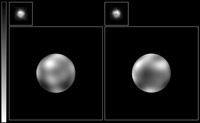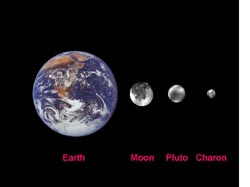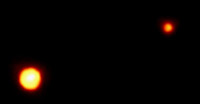Fig (1) The surface features of Pluto

Pluto is so distant and difficult to observe that it shows a blurred image even in the images of the Hubble Space Telescope.
Courtesy NASA-NSSDC
Pluto is the smallest of the planets, with a diameter of 2,400km, it is even smaller than our Moon (3,476km across); and the Earth (12,756km across) is nearly 500 times more massive than Pluto. If the Earth were hollow, there would be enough space for 150 Pluto-sized planets to be stuffed inside the Earth.
Fig (2) The relative sizes of the Earth, Pluto, Charon and the Moon

The image was created using NASA images of the Earth, Moon and Pluto.
The mean distance of Pluto from the Sun is about 6,000 million km. It is the farthest planet from the Sun for most of its orbit; in part of its markedly elliptical orbit it comes closer to the Sun than Neptune. Due to its vast distance from the Sun, Pluto is the coldest planet.
Pluto also has a relatively large moon (1,400km across) named Charon, which is regarded as the largest moon in the Solar System with respect to the size of its primary planet. The Pluto-Charon system is characterized by mutual eclipses, which are very important for studying these distant, mysterious objects.
Fig (3) Pluto and Charon, a Hubble Space Telescope image

Courtesy: NASA-NSSDC
Being so distant, cold and dark, Pluto was insightfully named by an 11-year-old girl after the Roman god of the underworld when it was discovered in 1930. Charon was discovered in 1978, and it was named after the mythological boatman who ferried the souls of the dead to Pluto, the lord of the netherworld.
Pluto's distance from the Sun varies greatly from 4,436 million km to 7,375 million km. Pluto orbits the Sun in about 248 years. For most of Pluto's vast orbit, Pluto holds the title of the most distant planet from the Sun; but as Pluto's orbit is highly elongated, sometimes it becomes closer to the Sun than Neptune .
On 21 January 1979 Pluto crossed the orbit of Neptune and became closer to the Sun than Neptune, and then, on 11 February 1999, Pluto crossed the orbit of Neptune again to regain the title of the farthest planet from the Sun.
It is also important to note that although the orbits of Pluto and Neptune appear to be intersecting, there is no chance of collision between the two planets as Pluto's orbit is inclined at about 17º to that of Neptune, and when Pluto is closer to the Sun than Neptune, it is either above or below the plane of Neptune's orbit.
Fig (4) The orbits of Neptune and Pluto
http://www.spacetelescope.org/images/large/heic0110c.jpg
Credit: ESA
Pluto rotates about its axis in 6.4 days, so the day of Pluto is about 153 hours long. Charon also rotates about its axis and revolves around Pluto every 6.4 days. So, like our Moon, which keeps the same side directed to Earth, Charon always faces Pluto with the same side, but the same is also true for Pluto: Pluto keeps the same hemisphere oriented to Charon. This is an unusual case in the Solar System, and the motion of the Pluto-Charon system really resembles a cosmic waltz!
Animation: The Pluto and Charon system (from the New Horizons Mission website)
http://pluto.jhuapl.edu/common/content/videos/animations/Pluto_Charon_system.mov
As Pluto and Charon perform their elegant dance; twice every Plutonian year, or once every 124 years approximately, the Earth is aligned to Pluto and Charon for five years; and Earth-based astronomers can observe Pluto and Charon mutually eclipse each other at intervals of nearly 3.2 days.
To an observer located on Pluto during such periods of mutual eclipses, Charon would eclipse the Sun every 6.4 days. Charon would also be eclipsed by the shadow of Pluto every 6.4 days. Likewise, an observer on Charon would observe a solar eclipse by Pluto every 6.4 days. The mutual eclipses last five years.
The last time this planetary alignment happened was in the period 1985 through 1990. It was a rare opportunity for astronomers to study the motions, orbits and physical characteristics (such as mass, size and density) of the two companions. The alignment will not be repeated again until the year 2109.
The skies of Pluto are much different from our skies. The apparent size of the Sun is less than 1/30 of that we observe from the Earth. The Sun from distant Pluto looks rather like a brilliant star. Charon can be seen from only one hemisphere of Pluto; and Charon remains motionless in the sky while the Sun and most other celestial objects move across the sky.
In the space era, all the planets except for Pluto have been explored by spacecraft. A spacecraft is due to be launched to Pluto in 2006. It is scheduled to arrive at Pluto in 2016.
Animation: New horizons Flyby of Pluto (from the New Horizons Mission website)
http://pluto.jhuapl.edu/common/content/videos/animations/PlutoFlyby.mov
Further Readings
Pluto New Horizons Mission |

